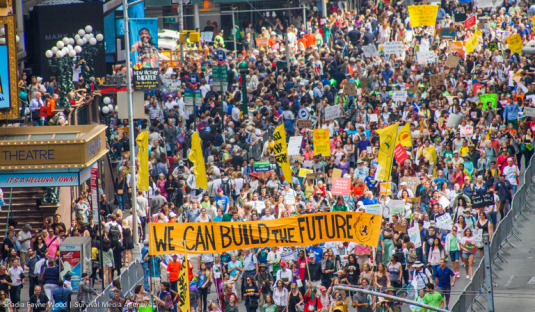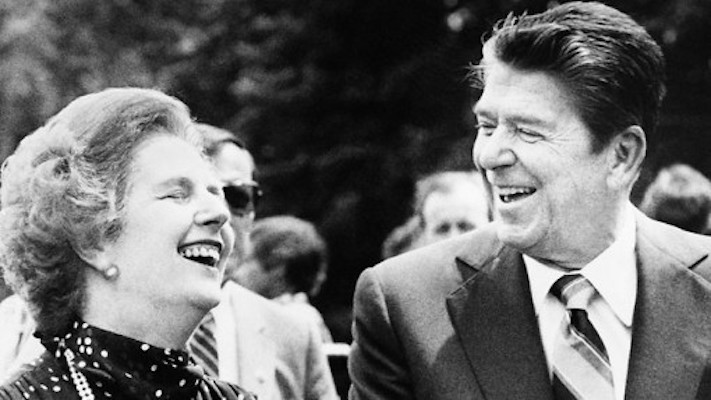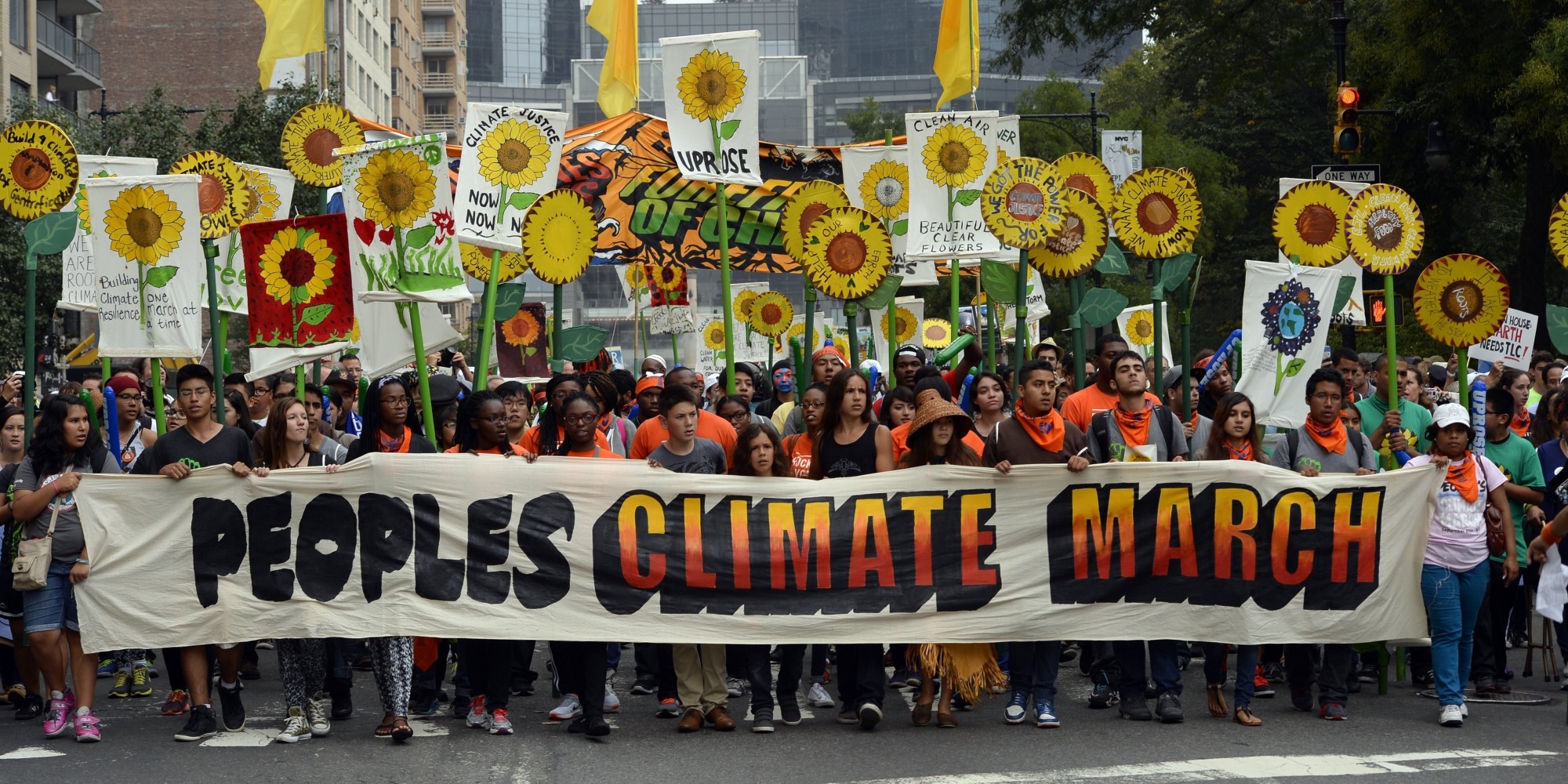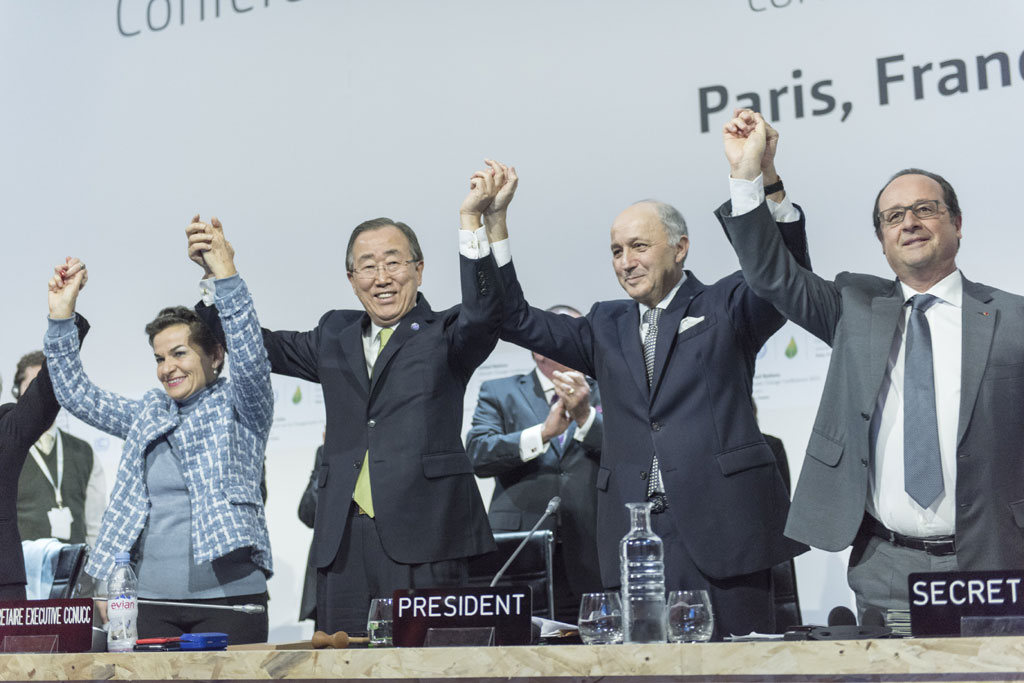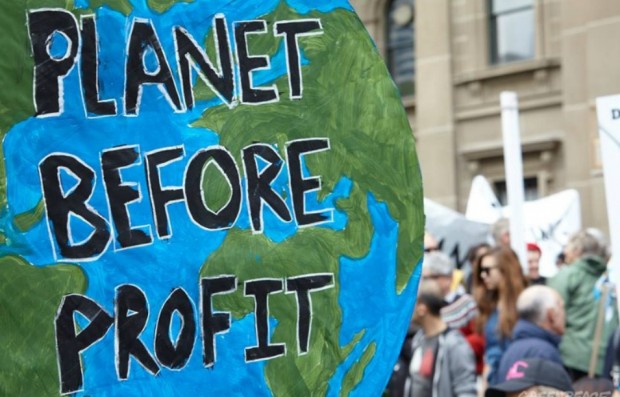With its strategy and our moral compass, the climate movement could be unstoppable.
By Chloe Maxmin
With the presidential election less than three months away, how are our nominees doing on climate change? Donald Trump rarely mentions climate. When he does, he mocks it. Hillary Clinton? She’s excited to say that she believes in climate change, while condoning fracking and lauding the deeply flawed Paris agreement. Still, we know that we need Hillary, and we must do everything we can to elect her. Most importantly—our movement must be more powerful than ever to push Hillary into the climate leadership that the earth demands.
How can the climate movement develop the political power to fight effectively?
To glean a few answers, I looked to what I regard as one of the most successful examples of social change in the modern era: the neoliberal coup. Between 1975 and 2008, an ideological movement called “neoliberalism” evolved from fringe theory into the dominant economic paradigm of our age, with great help from the Republican Party, and then, the Democrats as well.
Although the GOP is currently a global symbol of cynicism and desperation, it was not always so. The party apparatus facilitated a massive historical transformation over the course of several decades. The climate movement has no shortage of profound ideas, so my question is: What can the climate movement learn from the Republicans’ neoliberal coup?
FIRST, SOME BACKGROUND
Neoliberalism’s rise is well documented in books like Never Let a Serious Crisis Go To Waste, by Philip Mirowski, and A Brief History of Neoliberalism, by David Harvey. What I share here is merely the surface of an incredible story of social change.
Economist Friedrich Hayek convened the Mont Pelerin Society (MPS) in 1947 to develop an economic and social vision that would inoculate society from totalitarianism and collectivism. The idea was to make a decisive break from the state-centric regimes and ideologies of the first half of the 20th century. Hayek’s view held that individual freedom depended on replacing the state with the market as the means of economic coordination. The “invisible hand” of the market, he believed, produced more efficient and effective solutions along with more motivated, competitive, and autonomous people. The new body of theory that elaborated these ideas came to be called neoliberalism.
For decades, neoliberal economists were considered fringe theorists and excluded from Washington’s policy elite. The successes of the New Deal, and later the war effort, persuaded Americans that public institutions could meet shared societal challenges. In 1958, 73 percent of Americans trusted their government.
All that changed in the 1970’s. Stagflation—high unemployment, high inflation, and stagnant growth—gripped the US economy. Keynesian policies did little to alleviate the crisis. Many began to criticize government interventions for compounding the problem. Hayek and his American protégé Milton Friedman won the Nobel Prize for Economics in 1974 and 1976 respectively, raising the profile and legitimacy of the neoliberal doctrine that had been developing in the shadows for 30 years. Friedman was accepted into the inner circle of policy-oriented economic advisers, and Washington began to turn to his neoliberal frameworks. As Friedman explained, “when the time came that you had to change…there was an alternative ready there to be picked up.”
The advice was to embrace free markets and deregulation as the solution to stagflation. In 1976, President Jimmy Carter became an aggressive advocate for deregulation. Then came neoliberalism’s true champion, Ronald Reagan, in 1981. He mesmerized the country (and the world) with free market idealism expressed in anti-big government rhetoric, policies, and practices. Reagan’s focus not only produced decades of neoliberal policies in the White House but also birthed a massive ground game to infuse local politics and American culture with neoliberal values.
Something extraordinary happened in the decades that followed. Republicans recruited popular support with what Reagan called an “unswerving commitment to freedom” even as new neoliberal policies actually aimed to protect wealthy individuals and corporations. Reagan slashed the top income tax rate from 74 percent to 38 percent. Deregulation freed companies to ship jobs to low-wage countries. These practices set the stage for the rapid growth of income inequality that now marks our society. Historian David Harvey notes that “the median compensation of workers to the salaries of CEOs increased from just over 30 to 1…to nearly 500 to 1” between 1970 and 2000.
Despite the growing evidence of rising inequality and political manipulation, millions continued to support the neoliberal vision of deregulation and free markets. In 2002, 80 percent of Americans believedthat the free market was the best economic system. The Pew Research Center reported in 2014 that “majorities across the globe are willing to accept some inequality to have a free market system.”
Meanwhile, the climate movement marches forward, noble in cause, fighting for the people, committed to protecting everything that we love from chaos. Despite its righteousness, the movement struggles to influence the bones of politics and society. According to Gallup, Americans’ concern for climate change is relatively unchanged since 1989—moving only from 35 percent to 37 percent. Although 63 percent think that global warming is happening, only 48 percent think that humans cause it. We have no political champion in the highest offices. Our leaders avoid bold climate action, settling for weak compromises that allow crisis to grow unchecked.
Neoliberal thinking is now the status quo among Republicans, many Democrats, and most major institutions—it’s called “The Washington Consensus.” It was the Republican Party, though, that adopted neoliberalism as its guiding framework and propelled it to a level of political and cultural commitment to which most social movements can only dream. Despite the very different values and strategies at play, there are practical components of social change in the neoliberal triumph that have relevance to the climate cause. If a movement that produces so much suffering and corruption can overtake society, then a righteous movement of the people should be able to do that and more.
THE THEORY: SHARED VISION FOR A LONG GAME
The Republican’s neoliberal movement rests on a shared vision and a long-range understanding of how to translate that vision from theory to practice. From the very beginning, neoliberals were committed to a disciplined long game. MPS began articulating its vision in 1947, but it wasn’t until the 1970s that its ideology burst onto the public stage. During the intervening years, an extensive global effort prepared for the moment when neoliberalism would emerge victorious. As Daniel Stedman Jones writes in Masters of the Universe, this gestation period “helped turned neoliberal thought into a neoliberal political program.” The movement sustained a long term vision in order to build the power, insight, and agenda for political and cultural domination.
Neoliberals also insisted on a unified vision. For example, Jones writes that the 30-year neoliberal incubation from the 1940s until the 1970s “was held together by the Mont Pelerin Society.” Philip Mirowski writes that it was “a relatively shared ontology…with a more-or-less shared set of propositions about markets and political economy.” United by an explicit theory of change, the movement could operate in many different fields while furthering the same goals. This coordinated front made it possible to drive a new political, economic, and social agenda.
These principles of shared vision and a long-game perspective translated into the GOP’s conceptual and policy apparatus. As Jones writes, the 1980s witnessed “a fundamental move to a new political culture dominated by the free market…. Neoliberal thinkers and activists helped shape the changed economic approach epitomized by Thatcher and Reagan’s governments.” Every president that followed—both Bush presidencies, Clinton, and Obama—was thrust into an agenda already shaped by neoliberal politics. The durability of this transformation is reflected in the 2016 Republican Platform. The section on “government” reads: “Much of what the federal government does can be improved, much should be replaced, and much needs to be done away with or returned to the states.” This is the very vision that Reagan inculcated into the Republican Party in 1981, when he said “government is not the solution to our problem; government is the problem.”
The climate movement has developed as a social force since the 1980s, but it does not yet have the shared vision or long game capable of changing the core of American society. Our work tends to be defined by months or years, not decades. For example, the movement developed a multi-month plan around COP21, the international climate negotiations last December. Organizers prepared for COP21, rallied during COP21, and coordinated actions during the spring of 2016 to continue momentum. But where is our long game? Where is the intellectual framework that unites us, propels our work forward, coordinated and cohesive? As Robert Brulle, Professor of Sociology and Environmental Science at Drexel University, told me: “I don’t think that we have a long game at all…. Greens have really ceded the long-term intellectual arguments…to the conservative movement…. If you want to have long lasting staying power, you have to carry it out into the long term.” We need to know what we’re about, where we are going, and how we will get there.
The neoliberal movement’s vision was forged among an exclusive group of thinkers and then fed to a political party that champions elites. The climate movement will need to produce a shared vision in ways that are consistent with our democratic values. It’s been done before. In 1991, 300 delegates to the First National People of Color Environmental Leadership Summit crafted the “Principles for Environmental Justice,” a vision that still guides the environmental justice movement today. What if 300 climate activists convened to develop our movement’s framework?
THE PRACTICE: WADING INTO THE MAINSTREAM
An important step in the neoliberal ascent was clean, clear, compelling messaging that exemplified neoliberal values, garnered support, and could flow through the Republican Party. One word did most of the work: freedom. People should be able to do what they want, Republicans urged. The government shouldn’t interfere. The market knows best. These messages appealed to the economic frustrations of millions of people. They also allowed elected officials to pursue almost any agenda for the sake of freedom. Just look at George W. Bush’s rationale for the Iraq War. As he said at the beginning of the war: “The greatest power of freedom is to overcome hatred and violence.”
Another key component of the mainstream infusion was think tanks—institutions that incubated ideas and policies. Neoliberalism’s converts developed a “transatlantic network,” as Jones calls it, that established think tanks to further the cause. As Jones comments, these “nodes” absorbed ideas from neoliberalism’s Founding Fathers and turned them into innovative policy formulations. It was these think tanks that then nurtured neoliberal thinking for three decades, maintained close relationships with Republican politicians, and ultimately fed innovative policies to Washington’s elite for mainstream diffusion. The Heritage Foundation was ground zero for the GOP’s original position on individual mandates for health insurance. (In 1983, Ronald Reagan told a Heritage gathering that they were leading an “intellectual revolution.”)
The American Enterprise Institute, another conservative policy incubator, worked closely with George W. Bush, who said: “I admire AEI a lot—I’m sure you know that. After all, I have been consistently borrowing some of your best people.” Republicans’ attacks on environmental regulations and climate science stems from outfits like the Cato Institute. As historian Phillip Mirowski told me, “The real action is in the think tanks these days.” Mirowski adds that the left has “no conception of the amount of regimentation it takes to achieve something like this.”
The lack of a shared intellectual platform, clear mainstream messaging, and methodical implementation leaves the climate movement playing defense. The most prominent example is our endless battle against climate denial, a campaign that has been incubated in think tanks and propagated by many Republicans. A quick glimpse into the pervasiveness of climate denial: A recent study found that “oil industry ads outpaced climate-related coverage by almost 5-to-1” on CNN after 2015 was declared the hottest year on record. In the classroom, climate education is riddled with climate denial and misinformation. How can we make a new world when we’re constantly fighting the old one?
The best defense is a good offense. Brulle agrees that we need to “start taking examples from how effective the conservative movement has been and try to apply some of the strategies…. we need to expand our tactics to encompass some of this.” We focus on local specific campaigns to defend ourselves against the ever-present threats to home, family, and life. This work is crucial, but we also need to take the time to develop a vision, incubate our thinking, develop policies, disseminate new intellectual frameworks, and implement new action strategies. Some will say that the climate movement doesn’t have time to develop this kind of intellectual and political apparatus. My response: We don’t have the time not to. (A quick note: I am aware that the Republican neoliberal offensive was well funded by elite interests. I think that funding the climate movement’s growth is possible… but that’s an article for another time.)
THE POLITICS: FROM THE WEST WING TO WEST VIRGINIA
The next lesson to learn from the Republican neoliberal coup is the impressive top-down and bottom-up political apparatus. As Mirowski told me, true success stems from having a “central intellectual guide and a set of projects at the local, individual, parochial level.”
Neoliberalism found its most effective political champion in Ronald Reagan. He was the first successful politician in the postwar era to orient the American political system around a pro-business, pro–free market, anti-regulation framework. George H.W. Bush and George W. Bush advanced the cause after Reagan. Clinton and Obama pushed it hard too. But the Republicans also developed a genuine grassroots strategy. They intentionally activated new constituencies to solidify bottom-up support for the neoliberal vision. In the 1970’s, the GOP allied with evangelical Christians, the white working class, and later the white middle class under the banner of “freedom” and “free markets.” These voters reliably elected candidates who championed the neoliberal cause.
The climate movement simply does not have this kind of electoral or political power. We don’t have a top-down champion. Bernie Sanders was the only climate leader among the 2016 Presidential candidates. His climate leadership was not enough to win him the nomination. Hillary Clinton supports fracking and has set weak climate goals. Donald Trump has already checked out to another planet.
We’re outnumbered on the grassroots front too. According to Gallup, climate change is of “below average” importance this election. Only 58 percent of “consistently liberal” citizens vote all the time, compared to 78 percent of “consistently conservative” voters. Clinton is reluctant to lead boldly on climate for fear that she will lose moderate voters and wealthy supporters. Her vice-presidential nominee supports fracking and offshore drilling. The “climate vote” isn’t yet powerful enough to win political leaders’ attention or commitment.
Harnessing political power is the next challenge for our movement. It means finding new ways to influence politics while holding elected officials accountable for their actions. As a Nation Fellow this year, I am writing a book that explores concrete solutions to this challenge: How does the climate movement become a more effective grassroots political force?
The bad news is that the Republican neoliberal coup—united behind a cohesive ideology and a thoughtful political, policy, and PR long game—successfully infiltrated the very marrow of American culture and politics. Here’s the good news: The climate movement can do this, and do it better. We know that nothing can compare with a movement that fights for the many, not the few. Bernie Sanders’s political revolution demonstrates that many Americans are already in rebellion against a political class that protects only elites. The climate movements offers our society truth instead of denial, survival instead of chaos, justice instead of injustice, equality instead of inequality, and democracy instead of oligarchy. Our own unified vision, methodical long game, mainstream communication strategies, innovative policies, and political power can be forged by, for, and of the people.
Yes, reorienting our politics and society around climate justice is a monumental challenge, but it’s a challenge that we must face if we are to avoid the worst of climate change. Our movement can accept this challenge because we march in the name of love. What can stop us?
